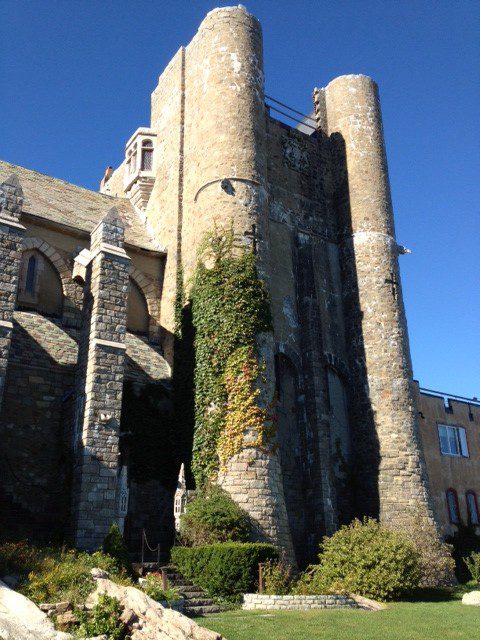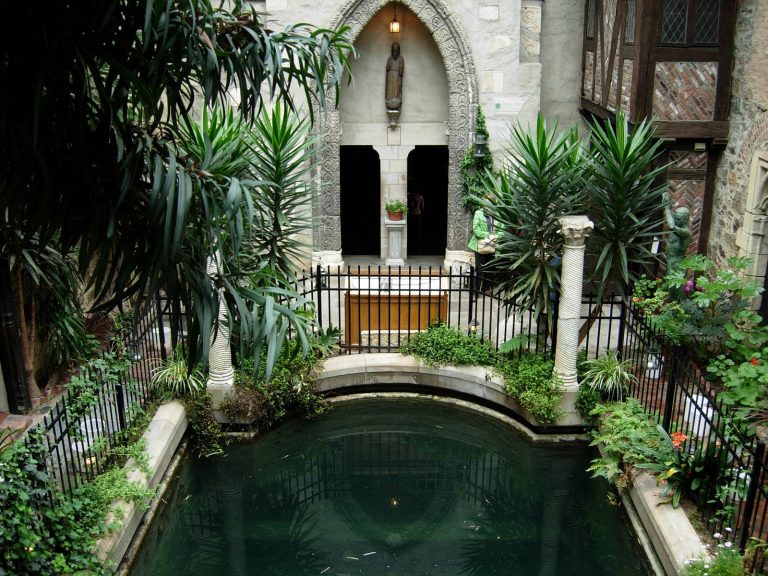
Hammond Castle, 1926-29, Gloucester, Massachusetts
I was interested to learn some years ago that the newest English translation of the work was going to be retitled “In Search of Lost Time,” to reflect more accurately the French title. I thought quite a bit about the difference between remembering the past, a relatively passive reflection on what has happened, and the far more poignant implications of seeking time that has disappeared, that is fundamentally irretrievable.
For me, a place called Hammond Castle is my madeleine dipped in tea. It is a medieval-style castle built in the 1920s by the inventor John Hays Hammond, Jr., set high on a cliff overlooking the sea in Gloucester, Massachusetts. Although it was Hammond’s house and scientific laboratory, because it housed his collection of ancient, medieval, and Renaissance art and architectural fragments, he almost immediately opened it as a public museum, even while he continued to live there. My grandparents and father, who summered in Gloucester, visited numerous times, and when I was growing up in the 1960s and 70s, they took me. For a young girl given to romantic flights of fancy, there was no better excursion. With a drawbridge placed between two round towers on one side, flying buttresses on the other, gloomy winding staircases, a cathedral-like great hall with stained glass, an enormous fireplace from a manor house, and an interior courtyard with facades of medieval shops set around a green-tinted pool, the entire structure was a fantasy of the medieval past. It mattered little to me what was real and what was not. Without a doubt, it was the foundation of my subsequent interest in the Middle Ages.
I think Hammond, and other collectors of medieval art in the early twentieth century, were looking for lost time. Revivalist movements of any kind could be described as such, but I think there’s something about medieval revivals that is different, that represents a longing for a historical moment that seems more difficult to recover than most because it appears to be so different than our present. We have a fantasy of the Middle Ages that has been filtered through and shaped by the passage of time, and we think of it as a period steeped in faith, mystery, and legend. As scholars we may scoff at such romantic constructions of the medieval, and instead search for the authentic, and eagerly point out the anachronistic. Most medievalists appear never to have heard of Hammond Castle, and it seems to be dismissed as a kitschy pastiche of the real and the fake.
Perhaps because I’ve turned 50, perhaps because I’m bored with my previous scholarship, I am not writing the book that I had expected to write. Instead, I’m searching for my own lost time, a time of innocence, of possibility, of romance. I’ve returned to Hammond Castle, but this time not as a child, but as an adult, as a medievalist. I’m not sure what I’m trying to find. I’m interested in what made Hammond, a man on the cutting edge of scientific technology, who invented radio control and designed top-secret inventions for the military, want to collect the art of the past and live surrounded by it in a castle. I’m interested in the provenance of the things he collected, and the way his collecting patterns and display affected subsequent museum design (the architect of Hammond Castle went on to design The Cloisters in New York). But as I sit alone in the dining room of the castle, poring over documents that have been unearthed for me by the present director/curator, with a fifteenth-century ceiling over my head, the medieval courtyard behind me, and the sparkling sea dancing just outside the windows, I feel returned to my past in a way that is viscerally satisfying. Local lore has it that the castle is haunted, that the ghosts of Mr. and Mrs. Hammond appear in balcony of the great hall under the reproduction of the stained glass window from Reims, speak French among the books on medieval art in the round library, and clink champagne glasses in the courtyard just outside the portal from Ravello that Hammond found dismantled in a basement in Naples. I hope and fear those ghosts will speak to me and divulge their secrets, tell me about their own pasts which are closer to my own in time but seem almost as culturally remote as the medieval objects they lived with.
This past summer I visited the castle with three scholars (including Material Collective original Jennifer Borland, who is working with me on a project thinking about revivalist monuments such as Hammond Castle, and Glencairn, Raymond Pitcairn’s home in Bryn Athyn, Pennsylvania). I also brought my father, who had not been back to the castle in years and years.

Indoor Pool, Hammond Castle, 1926-29, Gloucester, Massachusetts
My father was born the year Hammond Castle was begun; he is now 86 years old and in relatively poor health. He is also losing his memory. He deeply enjoyed going over the castle again with the curator, hearing all the stories that he had heard in his own youth about the shenanigans that went on in the castle among Hammond and his crowd of wealthy friends, including stars of music, stage, and film. After we left, I drove him all around the area, visiting his old ocean haunts; he had a remarkable ability to find hidden driveways and obscure houses he and his parents had rented in long-ago summers, even some he hadn’t seen in over 70 years. And yet, he became confused about some of the most basic details of his life when trying to recount them.
It is unlikely that we will be able to take such a trip again.
And so, I think I am trying both to remember a past, and search for a lost time, for both my father and me. My father and I share many things – a birthday, a love of the seaside, an appreciation of old, historic buildings, and a deep-rooted connection to Hammond Castle, even in its Disneyfied appropriation of the medieval style. In trying to pin down Hammond Castle, to wrestle it into some kind of scholarly order, I am finding that I don’t really care about authenticity, and clearly neither did Hammond. Hammond’s version of the Middle Ages is but one of many constructed tales that we tell about times that we can’t actually remember ourselves, and as my father’s experience has shown, even memories of our own past can become impossible to retrieve. Perhaps I am attempting to recapture a moment when my father was young and vigorous, when I could look at a castle and be swept away by my own imagination of the past and its gentle pressures on later historical moments, Hammond’s and my own, when memories were being formed and had not yet slipped into the crevices of time.
I still haven’t read Proust. Maybe next year
